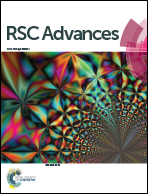In vitro–in vivo–in silico simulation studies of anti-tubercular drugs doped with a self nanoemulsifying drug delivery system†
Abstract
This study aimed to formulate a self-nanoemulsifying drug delivery system (SNEDDS) for enhanced pharmacokinetic (PK) behavior of rifampicin and isoniazid using excipients holding innate anti-mycobacterial activity followed with in vivo–in silico predictions using GastroPlus™. The optimized formulations of rifampicin (RIF-OF1) and isoniazid (INH-OF1) were characterized for drug loading efficiency, viscosity, optical clarity, particle size, zeta potential, morphological assessment and in vitro drug release. The oral bioavailability of RIF-OF1 and INH-OF1 was estimated in rats using validated UPLC MS/MS. The results of in vitro studies showed better drug loading, Newtonian rheological behavior and nanosized globular morphology of SNEDDS. In vitro drug release of both drugs was found to be higher at pH 1.2 and 6.8 as compared to their respective suspensions. The AUC and Cmax values of RIF-OF1 were increased by 3.72 and 5.22 fold compared to the RIF suspension, respectively, whereas INH-OF1 has shown that these values increased by 1.604 and 2.69 times compared to the INH suspension, respectively. Parameter sensitivity analysis predicted the considerable effect of solubility and permeability on main PK profiles. GastroPlus predicted maximum compartmental absorption of RIF-OF1 from proximal and distal portions of intestine whereas INH-OF1 was mainly absorbed from the duodenum and jejunum portions followed with improved PK parameters. The MIC value of the optimized formulation was reduced as compared to the pure drug indicating drugs acting in tandem in the explored carrier. The study suggested that the explored strategy could be a suitable alternative to conventional delivery systems for improved oral bioavailability of anti-tubercular drugs working in tandem.


 Please wait while we load your content...
Please wait while we load your content...